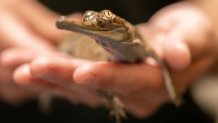The Fort Worth Zoo announced the "groundbreaking births" Thursday of "a historic conservation success" -- the hatching of four critically endangered gharial crocodiles.
Of the 35 gharial crocodiles living in U.S. zoos, four are in the care of the Fort Worth Zoo including one male and three females. The hatchlings announced Thursday were produced from two separate clutches, from two different females, and will introduce a new bloodline into the populations not living in the wild.
"The Fort Worth Zoo is the only institution in the United States to have produced multiple offspring of this critically endangered species," the zoo said in a statement. "The Zoo is incredibly proud to announce this groundbreaking conservation success, quadrupling the number of births to ever take place in the U.S."
Those visiting Thursday morning said they were surprised by the announcement and opportunity to see the four gharials.
Get DFW local news, weather forecasts and entertainment stories to your inbox. Sign up for NBC DFW newsletters.
"I've been coming to the Fort Worth Zoo once a week for 15 years," Sharon Martin said. "The minute I saw them, I fell in love. I got to hear one of the babies actually vocalizing, which was a teeny tiny little sound," Martin said. "But it was amazing to just get to be close to them… because they are so hard to breed."
All of the Fort Worth gharials are 42-43 years old. Gharial crocodiles can live up to 50-60 years, so it's possible the zoo could develop future clutches and hatchlings.

Efforts to breed gharials at the Fort Worth Zoo and help grow the worldwide population have been ongoing for more than a decade. Clutches have been laid at the Fort Worth Zoo before, but low fertility among eggs is a common occurrence with the species.
Local
The latest news from around North Texas.
“The team is incredibly proud and excited to finally have gharial hatchlings,” said Vicky Poole, associate curator of ectotherms. “Staff closely watched the developing eggs for the past few months and with each sign of life, our superstitious anticipation grew, just like a baseball pitcher throwing a no-hitter game. We were all pretty emotional with each hatching.”
The zoo said the gharial habitat in the Zoo’s herpetarium, the Museum of Living Art, was specifically crafted in 2010 with conservation as a priority.
Some of the efforts made to ensure optimal breeding success for this species include water temperature regulation, angled waterfront to provide easy access to both wet and dry areas with their short legs and heat coils in the sand to ensure the sand stays hot enough for the females to lay eggs.
“With this scientific breakthrough, we will be able to contribute our research and expertise to other zoos and institutions across the world in an effort to bolster the population of this critically endangered species,” said Michael Fouraker, Fort Worth Zoo executive director.
The babies, who have not yet been named and are not yet on display, will reach sexual maturity in about 13 years.
"It'll take a long time before they start showing their sexual characteristics, like, the male here has that large, it's actually like a sonic resonator on the tip of the snout," Poole said. "t's called a ghara, which is why they were called gharials. And that's a Hindi word for clay pot."
Though they are small in size now, they won't stay that way for long. Male gharials are slightly larger than females and can grow to 16 feet in length and weigh as much as 1,500 pounds.
"They're just a very unique crocodilian species with the long, skinny snout, their big eyes, even the texture of their skin is different than other crocodilians," Zac Foster, supervisor of ectotherms said. "These are one of my favorite species to work with and having the culmination of decades of work with them finally coming to fruition has just been a complete joy to be a part of and super, super grateful to be a part of this team."
The crocodiles are fish eaters that prefer clear freshwater rivers and are native to South Asia. They spend most of their time in the water, coming onto land to lay eggs and warm their bodies. By some estimates, there are roughly 1,000 gharials left in the wild, though the zoo said only about 200 of them are reproducing adults.
The International Union for the Conservation of Nature (IUCN) lists the species as critically endangered with their biggest threat being humans. National Geographic reports the gharial's numbers have declined 98% since the 1940s largely due to hunting and man's impact on their habitat.
The zoo said the births of the crocodiles are the first in the zoo's 114-year history and that it is only the second birth of gharial crocodiles in U.S. history, the most recent being a single hatching in 2016.



